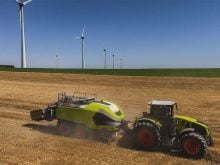Hannover, Germany — Volocopter built upon its passenger helicopter technology to develop a cargo drone that has agricultural applications.
The Volocopter is a German two-seat multi-rotor electric air vehicle designed for passenger air travel in an urban environment.
The company displayed its VoloDrone Demonstrator fit with John Deere spraying technology in John Deer’s future technology booth at Agritechnica in November.
“This is considered the third generation Volocopter. We stayed very true to our original designs in that it has a high redundancy in its propulsion system,” said Florian Reuter, chief executive officer of Volocopter.
Read Also

Why feds imposed EV tariffs
Moe and Kinew have a fight on their hands when it comes to eliminating the EV tariff. Canada has to worry about pissing off the U.S. and Mexico and hundreds of thousands of auto workers.
“There is high synergy in using technology that has already come to quite a mature stature both in the technology reliability and in the technology’s (ability to be certified).”
The VoloDrone has 18 individual propulsion units, is fully electric, and has a payload of up to 200 kilograms.
One battery charge on the exchangeable lithium-ion batteries enables a flight time of up to 30 minutes, and the VoloDrone can be operated either remotely or set to automatic with pre-programmed routes.
Reuter said Volocopter was asked by prospective customers to produce a cargo drone, and that the requests came from four major categories.
“Agriculture, logistics as a service for customers but also inter logistics within companies, shore to ship supplies for port logistics, and general industry applicants. For example construction, so anything where you need heavy lifting that is more dynamic or more flexible then a crane,” Reuter said.
“It has a very high redundancy on all critical components. Which means any critical components can fail and the vehicle can fully compensate for it and complete its mission.”
VoloDrone has been working with regulators around the world as it builds its passenger service, and Reuter said he expects it will be relatively easy to certify the drones in non-critical environments such as agricultural fields compared to operating in urban environments.
In Canada, the Pest Management Regulatory Agency has not yet registered any crop protection products for drone applications.
The VoloDrone Demonstrator’s frame is equipped with a standardized payload docking system, which enables different attachments to be mounted on the frame.
The John Deere sprayer attachment has two product tanks, a pump, and a spray boom.
VoloDrone Demonstrator’s nine-meter width determined how wide the boom could be.
“That’s important because you can only spray as far as your rotors reach. You wouldn’t go beyond because the downwash and the vertices that you create would be completely different where the rotors are covered and what is outside of where the rotors are covered,” Reuter said.
The original applications the company had in mind for the VoloDrone sprayer was for high value crops in difficult terrains such as steep slope vineyards, but the system will be tested extensively this summer to see if it fits other use cases.
Beyond spraying, Reuter said there will likely be other agricultural applications such as moving both empty or full boxes around during harvest.
He said it made sense for VoloDrone to partner with John Deere because it’s the biggest agricultural manufacturer in the world that can service customers all around the globe.
John Deere also has an impressive GPS signal capacity.
“I think this is a capability that we can directly translate into the third dimension,” Reuter said.
“We love the capabilities of John Deere with the StarFire GNSS enhancement system to really conduct extremely precise GPS trajectories anywhere in the world. This is a capability that we would like to tap into rather than build up this capability ourselves.”
















